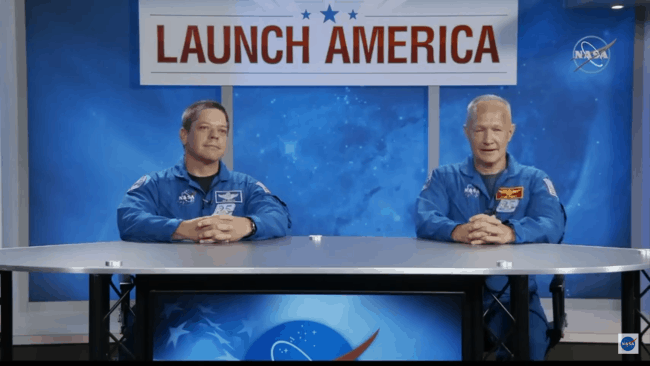NASA astronauts Robert “Bob” Behnken and Douglas “Doug” Hurley are excited and prepared to launch to space this month.
The veteran astronauts are scheduled to launch aboard SpaceX’s Crew Dragon vehicle from NASA’s Kennedy Space Center as part of the Demo-2 mission (DM-2) on May 27. This will be the first crewed launch from the U.S. since NASA’s space shuttle program ended in 2011. If all goes according to plan, on May 28 the mission will reach the International Space Station, where it will dock and the astronauts will spend up to 3 months (the exact duration of their mission is yet to be determined.)
Today (May 1), Behnken, the joint operations commander for DM-2 and Hurley, the spacecraft commander for the mission, chatted with the media ahead of this historic launch and shared that they’re both excited to take Crew Dragon on its inaugural crewed flight.
“I’m really excited for this NASA and SpaceX mission to bring human spaceflight back to the Florida coast,” Behnken said during the news conference. He went on to address the camera and say “hello to my son Theodore, hi Theo!” Behnken said that “on my first flight I didn’t have a small child, I didn’t have a son, so I’m really excited to share the mission with him.”
“I’m just glad to be a part of this whole big program,” Hurley said. Hurley and Behnken will launch from pad 39A at KSC, where they once took off aboard shuttles. “I think, in general,” Hurley added, “it’s well past time to be launching an American rocket from the Florida coast to the International Space Station and I am certainly honored to be a part of it.”
This flight will be not only the first crewed launch from the U.S. in nearly a decade, it will also be the first crewed launch in NASA’s Commercial Crew Program and a major development in commercial spaceflight and spaceflight history in general. But the astronauts demurred. “From the historical perspective, we’ll let somebody else talk about that when we get back,” Hurley said.
Hurley added that, while they are mission-focused, “I think Bob and I are very humbled to be in this position.”
The DM-2 launch is taking place as a majority of the world is self-isolating to slow the spread of COVID-19, the disease caused by a novel coronavirus.
This means that, while a historic crewed launch like this might be expected to draw enormous crowds during “normal times,” NASA hopes that this launch does not. Recently, NASA administrator Jim Bridenstine announced that not only will Kennedy Space Center be closed, he is also urging people to stay home and watch the launch remotely and safely.
Hurley called the fact that the astronauts’ family and friends will not be able to attend the launch “disappointing,” but added that it’s “obviously the right thing to do in the current environment … we want everybody to be safe.”
Hurley and Behnken both added that, while the quarantine they are living in will gradually become more restrictive as they near the launch date, they have been able to quarantine with their families for now.
Safety details
SpaceX’s Crew Dragon capsule is unique in a number of ways, including the amount of automation it incorporates. However, the crew on this flight will be testing the craft’s manual capabilities, which astronauts flying Crew Dragon capsules in the future will be able to access if they need to for safety reasons or to complete specific mission objectives.
“The Dragon spacecraft does have a lot of capabilities for us to intervene manually,” Behnken told Space.com during the news conference. “We do have a series of manual capabilities that allow us to really protect ourselves if the automation was to have some sort of a problem with it.”
Behnken added that Hurley “should have the opportunity a couple of times during the flight to manually fly the vehicle with those interfaces.”
That testing is a crucial safety measure for future flights. “We specifically, as part of this test flight, designed in some time in the pre-flight phase as well as close to space station so we can test out actual manual flying capability of the vehicle and verify that it handles the way we expect it to,” Hurley said. “It’s a prudent part of our flight test, just like anything else, in case the eventuality happened for a future crew that needed to take over manually and fly the spacecraft.”
Both Hurley and Behnken flew with NASA’s space shuttle program. Although the SpaceX Crew Dragon capsule is very different from the shuttle, both astronauts are accustomed to flying a wide variety of vehicles.
Still, this will be Crew Dragon’s first crewed flight so “statistics will tell you that’s riskier,” Hurley said. However, he added that not only are capsule designs generally safer than winged designs like Shuttle, “I am confident in both the SpaceX and NASA teams.”
Even as the capsule and rocket have been put through countless hours of testing, the astronauts themselves have completed equivalent training regimens. While the astronauts have been working through simulations, they have also been collaborating intensely with both NASA and SpaceX to ensure that the design makes sense and is the safest and most effective in completing their mission to reach the space station.
One of the biggest safety differences between the shuttle and Crew Dragon, Hurley noted, was that Crew Dragon has abort capabilities all the way from the launch pad to orbit. This is unlike shuttle, “where there were what we called black zones,” Hurley said about sections of the flight where no matter what you did, if things went really wrong “you were likely not going to survive an abort.”

